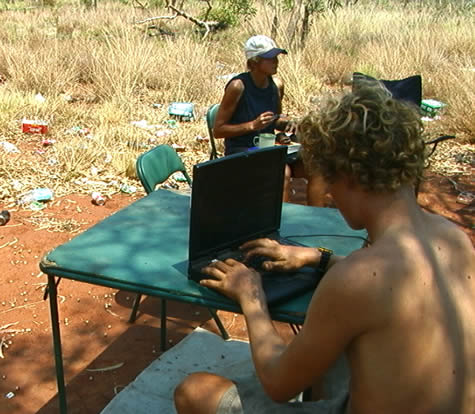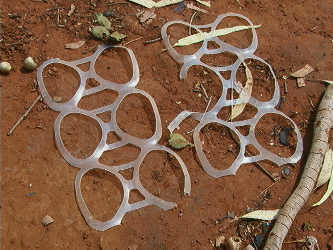THEME: Road to Lajamanu
SUBJECT: Education for Sustainable Development (ESD)
TOPIC: pollution

In the photo you see us sitting writing today’s updates. Around us you might also be see quite a large quantity of refuse that has been left here by other people who used this camping area previously.
During our editorial meeting, in which we sit around in a circle and decide who is going to write updates and on what topic, we entered into a debate as to whether the rubbish around us could actually be described as ‘pollution’ of the environment.
Practically everyone in the group first said ‘Yes, of course it’s pollution. Look at the mess!” But then someone spoke up and countered “But how is just ‘looking messy’ polluting the environment?” It was then clear that we had to define what pollution actually was before passing a judgement on our campsite. Such a judgement might be important, for example, if we felt it important to clear up the refuse ourselves, regardless of whether someone made the mess in the first place.

The definition of pollution is something that upsets the balance of nature. Or put more specifically, something that causes a negative effect on the environment, be it the soil, the ocean, the air or an animal or plant. Something might only become a ‘pollutant’ once it reaches a certain level of concentration in the environment. For example, the smoke from a small Bushfire may be easily assimilated (absorbed or diluted) into the atmosphere. However, when the amount of smoke and heat being released reaches a certain point beyond which it can be said to do ‘harm’ to the environment – like the smoke cutting out the sunlight in an area thereby affecting the ability of trees and plants to photosynthesise efficiently, or the combined heat of the fire contributing to global warming, which in turn affects the global ecosystem adversely – we can say it is a pollutant.
So, what about all the refuse around us? Well, the more we got to thinking and discussing it, the more we realised that we had to look at each piece of refuse individually to decide if it was a pollutant or not, rather than make a blanket judgement for all.
• Plastic ring pieces: we decided the plastic ring pieces that hold a 6-pack of drink cans together were the worst pollutants as they could get caught around the necks of goannas and birds, eventually suffocating them.
• Plastic bottles: next on the list would be plastic bottles that animals with long necks – like lizards - have been known to get their heads stuck in while attempting to drink the remaining fluid.
• Glass bottles: they’ve been known to start bush fires by the sunlight heating the inside of the bottle hot enough to light any dried grass that might be inside, in much the same way as a magnifying glass will. Also, if broken, shards of glass can cut and maim the feet of many different animals, including cows, wild horses and camels, and of course bare-footed bikers!
• Aluminium cans were not considered a pollutant, as we couldn’t think of an adverse affect on either plants or animals, and they take around 100 years to biodegrade into the soil – quite a short time on the greater time scale of things.
• Cardboard boxes: we decided cardboard boxes were also not a pollutant, as they will easily break down into the soil, especially when the rains come.
So, we have decided to clean up and dispose of appropriately the plastic ring pieces, plastic bottles and glass bottles, but leave the aluminium cans and cardboard boxes, even though (to us) they look unsightly.
One thing made clear from this exercise is that our judgement of what was a pollutant and what wasn’t was not always obvious, and was ultimately decided by our limited knowledge of the effects of the piece of refuse on the environment. Education and further research would therefore be needed in order to make better decisions in future.
Suggested learning activities:
1. Hold a debate in class about pollution in much the same way as we did at our editorial meeting. Make sure everyone in the class understands what pollution really means, thereby giving them the critical thinking tools for deciding for themselves what is a pollutant and what is not.
2. As the second half of the debate you might choose three articles of refuse regularly thrown away from our homes in the rubbish/garbage. Discuss the effects of those articles on the environment in which it is disposed (a landfill more often than not, if not recycled or re-used). Remember to include varying levels of each article of refuse in the discussion as a way of determining to what extent it is a pollutant.